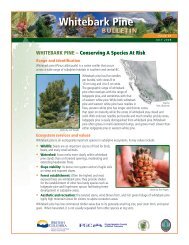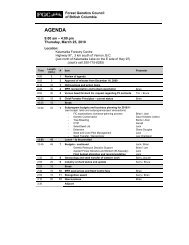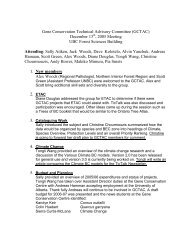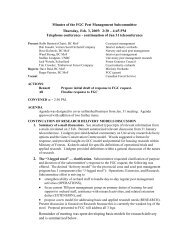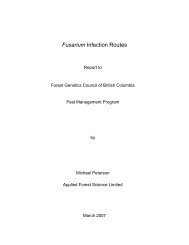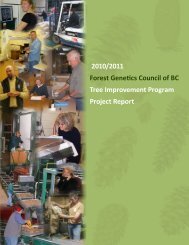Tree Improvement Program Project Report 2006 / 2007
Tree Improvement Program Project Report 2006 / 2007
Tree Improvement Program Project Report 2006 / 2007
You also want an ePaper? Increase the reach of your titles
YUMPU automatically turns print PDFs into web optimized ePapers that Google loves.
concentration, the complete fertilizer increased stem P at<br />
Eagle Rock.<br />
Slight to moderate N deficiency in lodgepole pine is<br />
shown by needle N concentrations of 1.15-1.35. Hence<br />
the control N concentrations at Kalamalka (1.65%) and<br />
Eagle Rock (1.42%) do not indicate N deficiency. Needle P<br />
was a little lower at Eagle Rock than at Kalamalka and was<br />
increased by fertilization, but the values do not indicate a<br />
serious deficiency.<br />
Leaf S values ranged from 0.088 to 0.098%. At<br />
Kalamalka the control averaged 0.120 but dropped with<br />
fertilization to as low as 0.099. At Eagle Rock the value<br />
averaged 0.130, so neither Kalamalka or Eagle Rock<br />
showed S deficiency. However, the ratio of N:S is thought<br />
to be about 15 under optimal nutrition. While the N:S<br />
ratio at Kalamalka was about 15, it was driven down by<br />
the complete fertilizer. At Eagle Rock the N:S ratio was<br />
uniformly below the optimum (15), which suggests that<br />
there is insufficient S uptake to balance N and that remedial<br />
treatment should be considered.<br />
The present experiment was designed to compare the<br />
effect of N alone with a complete fertilizer. The N source<br />
(NH 4 NO 3 ) was the same in both fertilizers. The rate of N<br />
application was 150 kg ha 1 and will be re-applied in the<br />
second year of treatment (<strong>2007</strong>). The quantity of S in the<br />
complete fertilizer will be increased so that 50 kg S will<br />
be applied. This will be done by increasing the amounts<br />
of potassium sulphate (0-0-50) and magnesium sulphate<br />
(MgSO 4 anhyd.).<br />
.2.12 The Effect of Seed Orchard<br />
Locat on on Progeny<br />
Performance: Seed Orchard<br />
After-effects (SPU 1 22)<br />
Joe Webber and Barry Jaqu sh<br />
Introduct on<br />
Over the past 10 years, research results have shown that<br />
the parental environment can affect progeny performance.<br />
In a seed orchard context, after-effects is the term used to<br />
describe the differential response of progeny derived from<br />
parent trees selected in the north (or high elevation), and<br />
propagated and cultured in the south (or low elevation).<br />
T R E E I M P R O V E M E N T P R O G R A M<br />
P R O J E C T R E P O R T 2 0 0 6 / 2 0 0 7<br />
When compared with their northern counterparts, progeny<br />
produced from southern seed orchards showed delayed<br />
de-hardening and bud flush in the spring, delayed growth<br />
cessation during the summer, and delayed frost hardiness<br />
development in the fall (see Stoehr et al. 1998 and Webber<br />
et al. 2005 for reviews 1 ).<br />
The effect appears to act only through maternal, and<br />
not paternal, reproductive development. Seed orchard<br />
after-effects may have an important biological significance,<br />
but are they operationally significant? The Prince George<br />
plantation was established to assess the operational<br />
significance of after-effects and answer the question: does<br />
progeny derived from seed produced in Vernon meet<br />
expected performance for growth and adaptive response in<br />
Prince George?<br />
In British Columbia, interior spruce orchards are<br />
established in more southerly, drier, and warmer locations<br />
(Vernon), but progeny from these orchards can be deployed<br />
considerably further north (Prince George). Temperature<br />
differences between Vernon and Prince George may affect<br />
frost tolerance (Webber et al 2005) and growth traits<br />
(height growth; bud burst).<br />
Since photoperiod during reproductive development<br />
in Vernon is shorter (neutral) than in Prince George (long<br />
day), experience with seed after-effects in Norway spruce<br />
suggest that progeny from Kalamalka may flush later and<br />
set buds later than their northern counterparts. The two<br />
plantations at Prince George offer an extensively designed<br />
experiment to determine if photoperiod after-effects occur<br />
in progeny from two distinctly different seed production<br />
areas (Prince George and Vernon). Plantation survival and<br />
height growth were determined after the first year (2001).<br />
This report summarizes data collected in <strong>2006</strong> for bud<br />
burst and height growth at two Prince George plantations.<br />
Procedures<br />
The experimental design, crossing scheme, and nursery<br />
aspects of this project were completed over a period of 1996<br />
1 Stoehr, M.U., L’Hirondelle, S.J., Binder, W.D. and<br />
Webber, J.E. 1998. Parental environment after-effects<br />
on germination, growth, and adaptive traits in selected<br />
white spruce families. Can. J. For. Res. 28:418-426.<br />
Webber, J., Ott, P., Owens, J., and Binder, W. 2005.<br />
Elevated temperature during reproductive development<br />
affects cone traits and progeny performance in Picea<br />
glauca x engelmannii complex. <strong>Tree</strong> Phys. 25:1219-1227.



